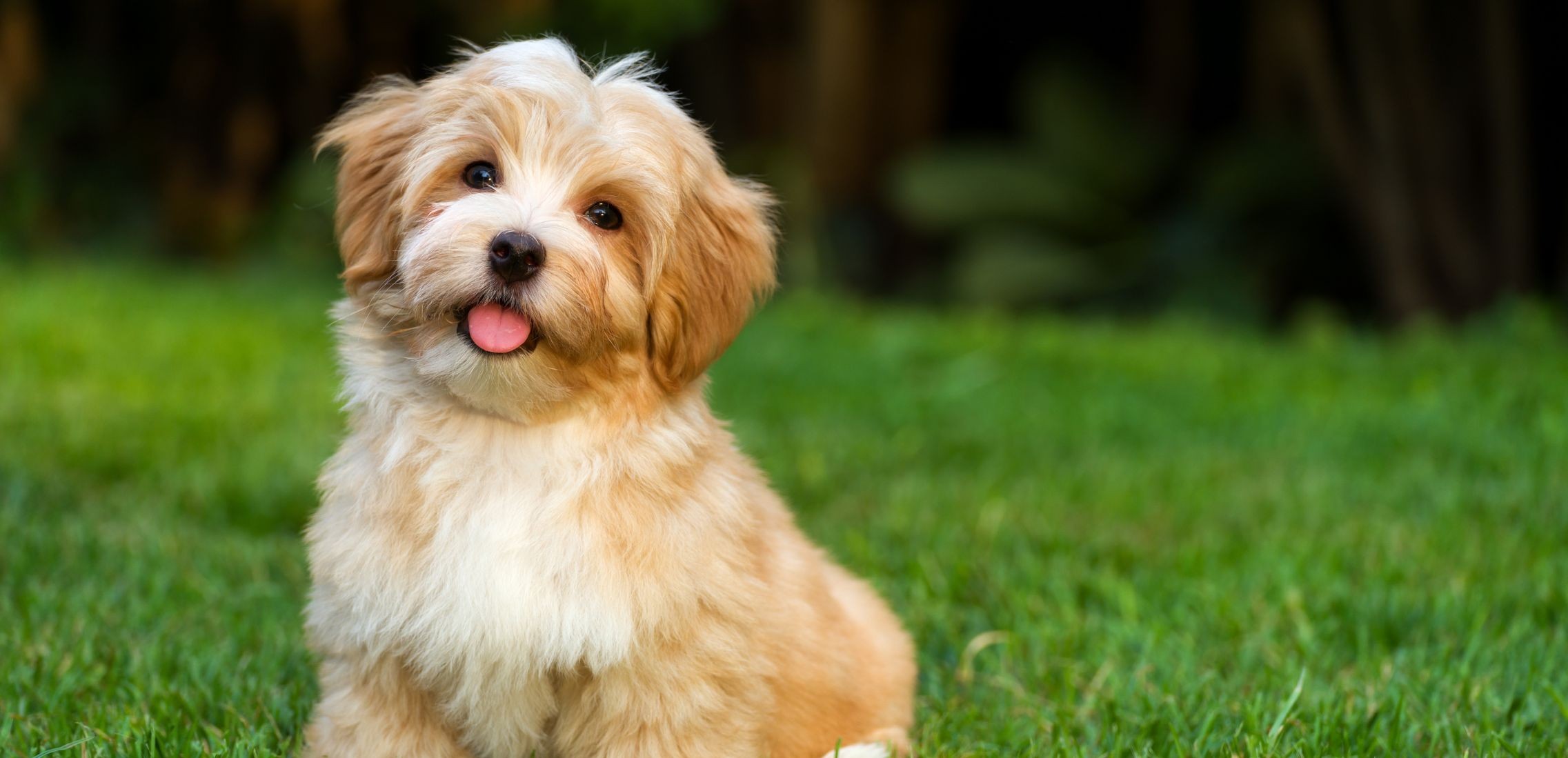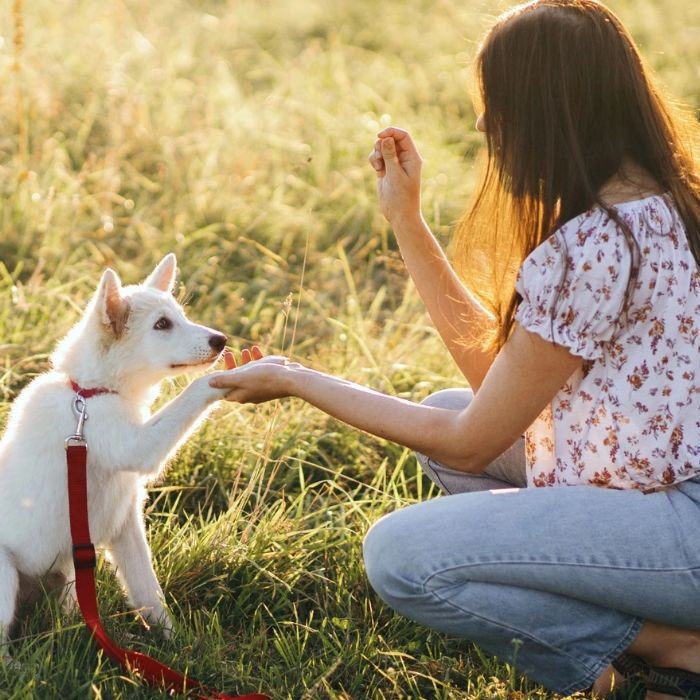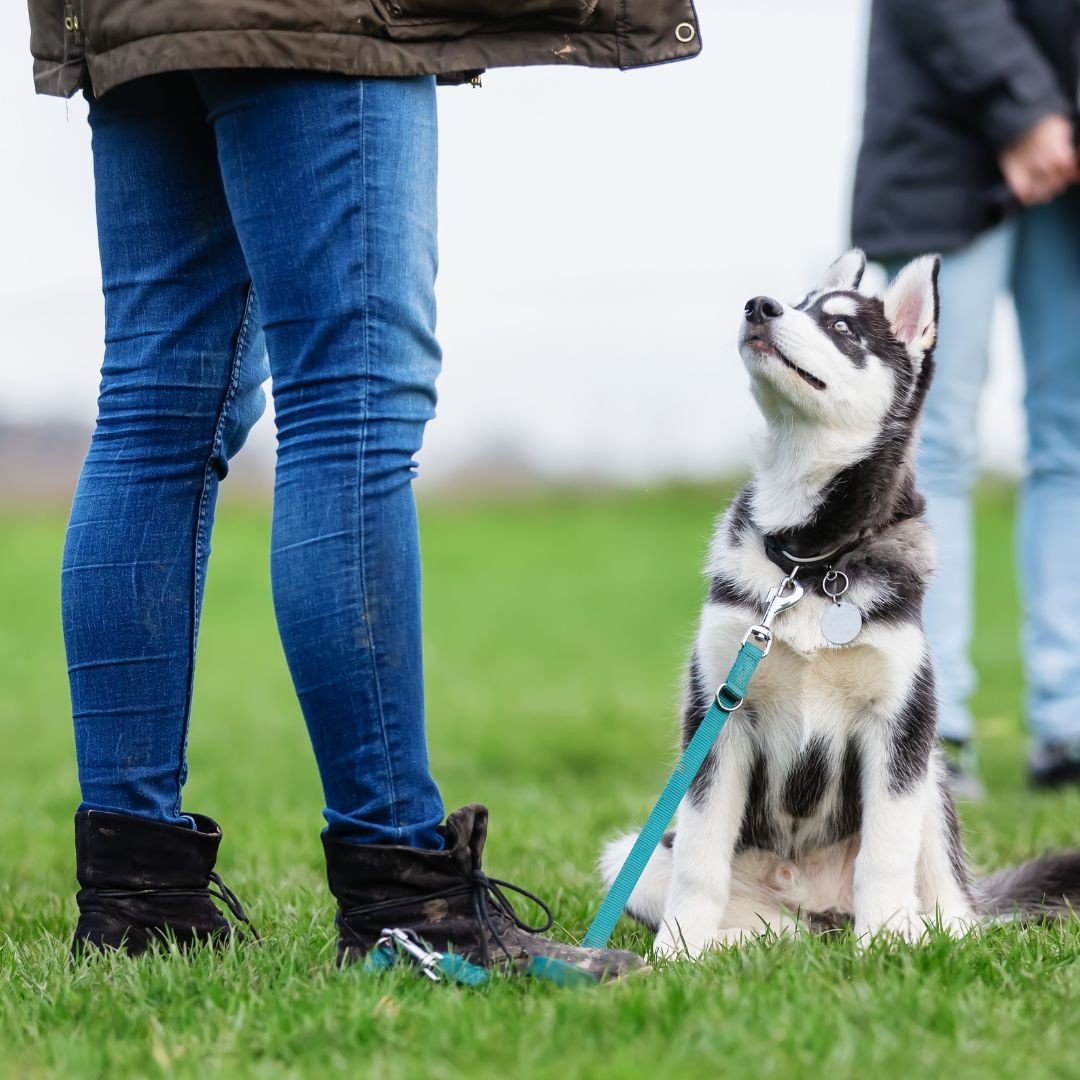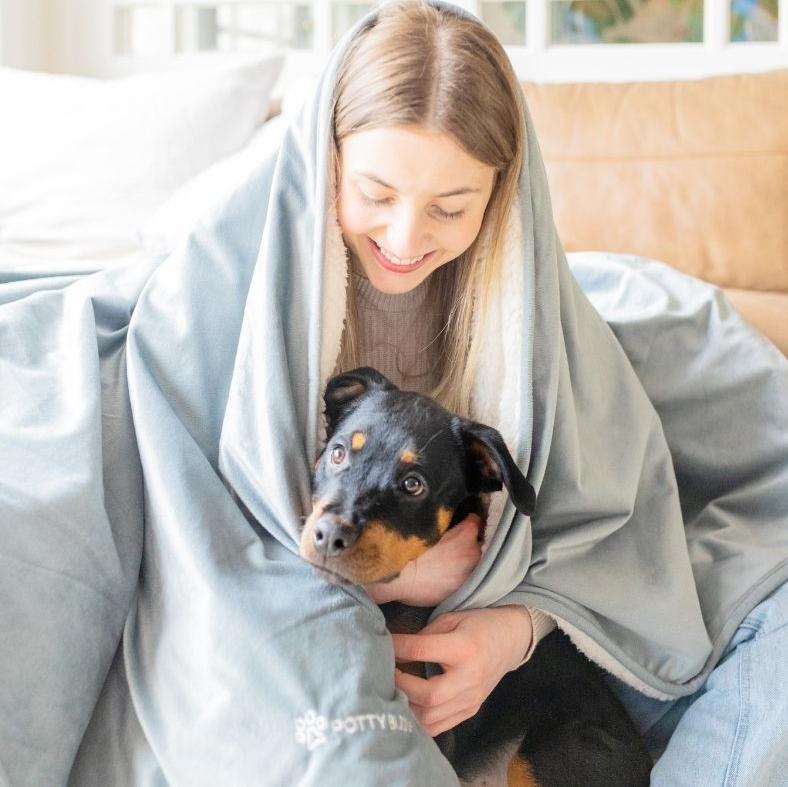Your Cart is Empty
Get Up To 35% OFF & Free Delivery
Get Up To 35% OFF & Free Delivery
Get Up To 35% OFF & Free Delivery

So your dog doesn’t currently know how to sit…but what’s the worst thing that could happen from them not knowing this command?
Well, just imagine: your dog isn’t familiar with any commands and doesn’t know how to sit when asked. Then one day, as you open the front door to let a guest in or take in a delivery, your dog bolts out, running loose into the neighborhood and heading straight into oncoming traffic.
Yikes!
We understand how scary the prospect is of your dog being unable to listen, and the idea of losing your furry friend forever. Nothing is worse than the thought of never being able to find and catch your dog after it escapes, simply because your pup didn’t sit when asked.
That’s why today we'll teach you great tricks to help your dog nail the sit command and tips for making training sessions smooth and successful. Let's get started!
Teaching your furry friend basic skills is so important and sitting is a fundamental skill every dog needs to learn. A correct sit helps develop balanced muscles and good posture in dogs, which contributes to their overall health and well-being.
What if you were on a walk one day with your dog, and suddenly, a kid on a bike came out of nowhere? Or you want to invite family and friends over to your house, however the minute the door opens, your dog bolts out of the doorway?
The sit command can help you gain control over dangerous situations, keeping you and your dog safe. Not only is this a foundational skill, but it is also one that is used to build upon more tricks you may want to train your dog to do. However, a sloppy sit can lead to muscle imbalance and stiffness in a dog's hips, so it's important to teach them to sit properly.
Not only can it assist with your dog's safety; teaching the sit command can also help to grow your bond with your canine companion too. It's a key way to help your dog to focus on you and to be more attentive to any additional commands too. Teaching a dog to sit straight promotes proper body structure and conditioning, which is beneficial for their long-term health.


Before you get started, you will need tasty treats your dog loves. We love having a treat pouch or bag easily accessible to reward our pups instantly when they successfully follow a command, as this will help to solidify the positive reinforcement of this skill.
So, have your treats within easy reach and then you’re ready to follow the following steps…
We'll break down training this skill into six easy steps. That way, you’ll have your dog sitting in no time.
Remember to read through all steps before you start, so you have a better understanding of the entire process.
Small pieces of cooked chicken, hot dog bits, or cheese chunks; basically anything that will make your dog drool. If you’re not sure which treats would be best for your pup, check out this rundown of the Best Dog Training Treats of 2025.


Now that you have some tasty treats ready to hand, it's time to capture your pup's attention. We like placing the treat between our index and middle finger, right in front of our dog’s nose. Keep the treat close enough for them to focus on.
Slowly lift the treat upwards and slide it back so they are lifting their nose, and as they lift their nose, their rear end will sit. Stay close to their noise if they try to jump for the treat.
Timing is everything when giving your pup praise. The instant their furry bottom touches the ground, praise them enthusiastically and give them the treat. A simple "Yes!" or "Good!" in a happy tone lets the dog know they've done exactly what you wanted. Be consistent so they understand and associate the behavior with the command. Mark the behavior by saying "Yes!" or clicking the moment their rear touches the floor to reinforce the action.
You know the saying, "Practice makes perfect!" But be aware that puppies in particular have short attention spans, so break the training into several short sessions throughout the day. If your dog loses interest, it is time to end the session. Always end each session with positive vibes and your dog successfully completing a command.


You don't need a command or verbal cue to start. However once your dog is successfully completing the command by you luring the treat, you can start associating the action with a verbal cue and hand signal. Use a simple "sit" command and hand signal in an upward motion, with the palm facing up and your arm moving upward.
Say the cue and do the hand signal right before luring them into the sit, so they start to associate the words and gestures with the action. With enough repetition, they'll learn to sit on cue without needing the lure. To teach a dog to sit, hold a high-value treat near their nose and move it in an arc over their head towards their tail, encouraging them to sit naturally.
Treats are powerful! Yet many pet parents don't want to carry treat pouches forever. Once your pup starts mastering the sit command, offer other rewards instead of treats. Like verbal praise such as "Good boy," "Great Job," "Yes." You can also add more skills by making your dog stay in the sit position for longer, and once you give them a "break" command, they will get to play tug-a-war, fetch, or hide and seek. Provide less treats as you add more command or play rewards. Vary the rewards to keep your pup always thinking and using their mind trying to figure out what's next.
And a bonus tip to remember:


You may have a little setback every now and then. Go back to a simple sit command and gradually add on from there. The second time around, they will pick up quicker, and you can move to a longer sit stay. Once you are not in the thick of it, reassess the situation and think about what was happening around you at the time of your pup’s setbacks. Distractions? Was the training session too long? Did you run out of treats? Assess and pivot for the next session.
The most important thing is to practice “sit” every day with your dog. Also, switch up the locations where you train and the treats you reward to keep things interesting. Practice the command in different environments with increasing distractions to reinforce learning and ensure your dog can perform the command reliably in any situation.
Be positive and consistent while training, and your pup will master sit in no time!
We want to provide you with the keys for successfully training your dog to sit. These tips and strategies will help you overcome any training obstacle that might get in your way.
Ultimately, we want your training sessions to be enjoyable and help you build a stronger bond with your furry friend.
Training sessions should last no longer than 5-10 minutes in the beginning and never over 20 minutes. Your dog's attention span is not that long. Short and frequent is the key.


Once you have introduced verbal commands, you want to use the same verbal commands and hand signals every time. Your dog will be confused if you say "sit" and your kids say "sit down."
These may seem the same to us, but our dogs can get confused when we add words to the command. Make sure everyone in the family is consistent so you can set your dog up for success. Training sessions will be smoother if you are consistent.
Keep distractions to a minimum in the beginning. You want your dog to have a successful training session. Too many distractions can make your dog lose focus faster, leading to a shorter session. Find a quiet and controlled space to train, not a park or your backyard at this point.
Keep things interesting for your dog. Us humans don't like doing the same things over and over every day, and neither do our dogs. Make the training session like a game. Make your dog sit before they can go on a walk. This helps with their self-control and mixes things up for them. Play hide-and-seek—have your dog sit and stay while you hide. Then call them to search for you.


Try to stay positive during your training sessions. If you or your dog are distracted, you are not setting the training up for success. Training your dog should not be on the schedule if you are having a bad day or super short on time. Just start again tomorrow. You want to try to keep your training sessions positive.
You won't get there overnight, and that's okay! Keep your sessions short and sweet, and celebrate the small victories along the way. Whether you've got a wiggle worm like a Goldendoodle or a stubborn Shiba Inu; every dog learns at their own pace. Dogs may take longer to learn the sit command depending on their individual pace and personality, so patience is key.
Use your dog's meal time as a training opportunity. You can use their kibble as a reward to teach them new tricks. As a pet parent, we're often worried about overfeeding our dogs with extra treats and then feeding them a full meal. This one is a win for you both. You get to train, and they get their meal. Incorporating crate games can also teach a dog to sit by associating the behavior with the door opening, making training more engaging and practical.
These tips will have you well on your way to training your furry friend to sit. And these training sessions will help build a lasting bond with your dog for years to come.
Be patient, keep your sense of humor, and celebrate the wins.


Are you ready to impress your friends with your dog training skills?
Then level up your dog’s sit with the "sit pretty" trick. This trick is often referred to as the “beg” trick, where a dog is sitting but their front paws are raised.
So, ready to learn how you can level up your dog training and to teach your dog to sit pretty?
Let's do this!
Start with a Sit: You want a comfortable and relaxed pup.
Use a Non-Slip Surface: A non-slip rug on hardwood floors or carpet will work. You want a non-slippery surface so your pup can grip easily and their paw pads don't slide around, giving them traction and stability.
Hold a Treat Above Their Nose: Grab some high-value treats to get your pup's attention. Hold the treat just slightly in front of your dog's nose. Move it slowly up to encourage them to lift their front paws off the ground without jumping up.
Reward Immediately: Reward them once they lift their paws off the ground. Be ready to reward them instantly once they make the slightest lift. Then keep asking for more lift as you continue, until they fully sit on the hind leg with their cute little paws in the air.


Give a Verbal Cue: We like luring our dogs until they start getting the hang of the command before we add a cue or hand gesture. Decide what command you are going to use once they are ready. We prefer "sitting pretty" or "beg." The hand signal could be raising your hand upwards, but make sure not to use anything similar as you don't confuse them.
Increase Duration Gradually: You can start making them hold the positions longer before you reward them. Begin with just a few seconds and gradually work your way up.
Practice Regularly: Start adding this command to your training sessions. The more you practice, the better they will get at performing their new tricks.
Use Positive Reinforcement: We are huge advocates of using positive reinforcement in our training sessions. Keeping a positive attitude and praising your dog along the way will keep your dog bonding and engaged during training sessions. A happy dog is a learning dog!
Stay positive, patient, and consistent with your training sessions, and your dog will “sit pretty” like a pro before you know it.

The sit command is foundational and a building block for other training tricks, as well as a core command to help keep you and your dog safe in potentially dangerous situations. That’s why it’s one of the top skills to train a puppy in their first years.
Stay consistent and keep training sessions enjoyable, and remember to make your training session short and fun.
You got this!
Follow Us On
Check Out Our Most Popular Content